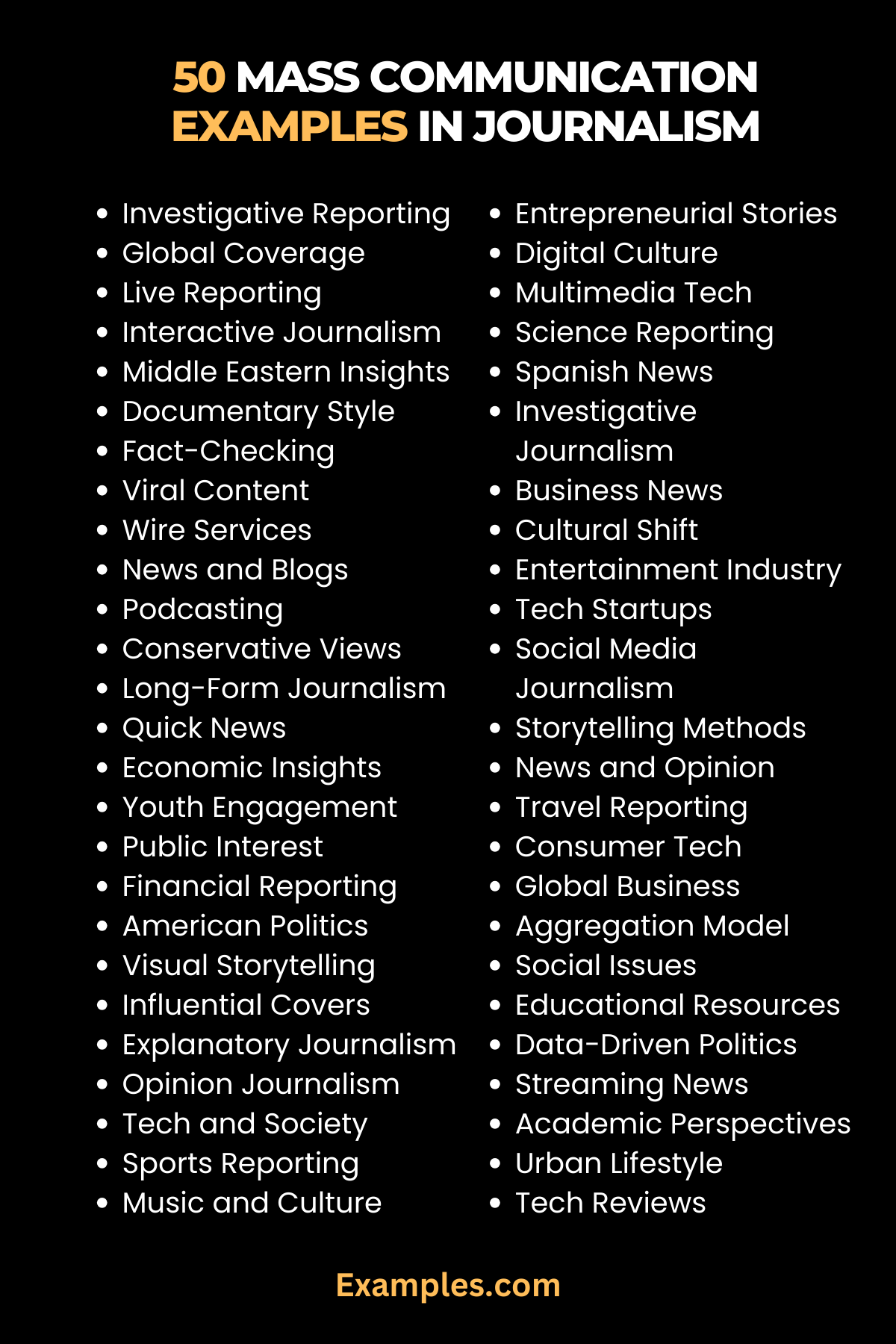49+ Mass Communication Examples in Journalism Examples
In the dynamic world of journalism, Mass Communication plays a pivotal role. This guide explores Mass Communication Examples in Journalism, offering insights into how journalism shapes public discourse and opinion. With a variety of sentence examples, we illuminate the intricate relationship between journalism and mass communication. From groundbreaking news reports to innovative digital storytelling, these Communication Examples demonstrate the profound impact of journalism in informing and engaging the public. An essential read for understanding the power of the press in the digital era.
50 Mass Communication Examples in Journalism
Explore the diverse landscape of Mass Communication in Journalism with our curated list of 50 standout examples. Each one showcases the dynamic nature and impactful reach of journalism in the digital age. From groundbreaking investigative reports to innovative multimedia storytelling, these examples highlight key trends and best practices in Journalism Mass Communication. They serve as a valuable resource for understanding how journalism continuously evolves to inform, engage, and influence the global audience.

- Investigative Reporting: The New York Times The New York Times exemplifies top-tier Investigative Journalism, uncovering major stories with thorough research and compelling narratives.
- Global Coverage: BBC BBC’s wide-reaching Global News Coverage sets a high standard for Broadcasting Mass Communication, delivering news from every corner of the world.
- Live Reporting: CNN CNN masters the art of Live News Updates, providing real-time coverage of unfolding events, a hallmark of Broadcasting Mass Communication.
- Interactive Journalism: The Guardian The Guardian integrates Interactive Elements in its reporting, making complex stories more engaging and understandable.
- Middle Eastern Insights: Al Jazeera Al Jazeera brings critical Middle Eastern Perspectives to the global stage, filling a gap in International Journalism.
- Documentary Style: Vice Media Vice Media stands out for its Immersive Documentary Reporting, offering deep dives into diverse topics.
- Fact-Checking: The Washington Post The Washington Post’s Fact-Checking Service is pivotal in combating misinformation, upholding the integrity of Journalism Mass Communication.
- Viral Content: BuzzFeed News BuzzFeed News has redefined news for the digital age, blending Viral Content with serious journalism.
- Wire Services: Reuters Reuters excels in fast and reliable Wire Service Reporting, a backbone of contemporary News Journalism.
- News and Blogs: HuffPost HuffPost combines traditional news with Blog Elements, catering to a diverse online audience.
- Podcasting: NPR NPR’s Educational Podcasts use storytelling and analysis to delve into complex issues, reflecting Mass Personal Communication trends.
- Conservative Views: Fox News Fox News represents Television Mass Communication with a focus on conservative viewpoints and political commentary.
- Long-Form Journalism: The Atlantic The Atlantic is known for its Long-Form Cultural Journalism, exploring societal trends with depth and insight.
- Quick News: Axios Axios offers a fresh approach with its Concise News Format, catering to the fast-paced digital reader.
- Economic Insights: The Economist The Economist stands as a prime example of in-depth Economic Reporting in Journalism Mass Communication.
- Youth Engagement: Teen Vogue Teen Vogue has evolved to cover political and social issues, engaging younger audiences in Mass Communication.
- Public Interest: ProPublica Nonprofit ProPublica focuses on Public Interest Journalism, highlighting crucial societal issues.
- Financial Reporting: Wall Street Journal The Wall Street Journal is a leading voice in Financial Journalism, offering comprehensive market analysis.
- American Politics: Politico Politico specializes in American Political Coverage, influencing the political communication landscape.
- Visual Storytelling: National Geographic National Geographic combines stunning photography with in-depth reporting, showcasing the power of Visual Journalism.
- Influential Covers: Time Magazine Time Magazine’s Cover Stories have become influential pieces in modern Mass Communication.
- Explanatory Journalism: Vox Vox is renowned for its Explanatory Journalism, breaking down complex topics for a broad audience.
- Opinion Journalism: Slate Slate offers a platform for diverse Opinion Pieces, contributing to the variety of Mass Communication.
- Tech and Society: Wired Wired explores the intersection of technology and society, a growing area in Mass Communication.
- Sports Reporting: ESPN ESPN covers a wide range of sports, representing the diversity in Sports Journalism.
- Music and Culture: Rolling Stone Rolling Stone provides in-depth coverage of music and popular culture, reflecting evolving Cultural Journalism.
- Entrepreneurial Stories: Forbes Forbes focuses on business and entrepreneurship, highlighting the importance of Economic Journalism.
- Digital Culture: Mashable Mashable covers digital trends and tech news, exemplifying the impact of Digital Journalism.
- Multimedia Tech: The Verge The Verge uses various digital formats to report on technology, illustrating the versatility in Mass Communication.
- Science Reporting: Scientific American Scientific American makes scientific knowledge accessible, showcasing the role of Science Journalism.
- Spanish News: El País El País offers Spanish-language coverage, highlighting diversity in International Journalism.
- Investigative Journalism: The Intercept The Intercept is known for its bold Investigative Journalism, focusing on deep-dive reporting.
- Business News: Bloomberg Bloomberg provides comprehensive coverage in Business Journalism, a key sector in Mass Communication.
- Cultural Shift: MTV News MTV News now covers a wide range of topics, reflecting shifts in Media and Culture.
- Entertainment Industry: Variety Variety is known for its in-depth Entertainment Industry Reporting, a niche in Mass Communication.
- Tech Startups: TechCrunch TechCrunch focuses on startup news, representing the evolving landscape of Technology Journalism.
- Social Media Journalism: AJ+ AJ+ uses short-form video on social media, illustrating the rise of Social Media Journalism.
- Storytelling Methods: The Outline The Outline employs unconventional storytelling, showcasing innovation in Digital Journalism.
- News and Opinion: The Daily Beast The Daily Beast offers a mix of news and opinion, reflecting diversity in Mass Communication.
- Travel Reporting: Skift Skift provides specialized coverage of the travel industry, an example of niche Journalism.
- Consumer Tech: Gizmodo Gizmodo offers news and reviews on consumer tech, a key area in Technology Journalism.
- Global Business: Quartz Quartz provides international business insights, reflecting globalization in Mass Communication.
- Aggregation Model: The Drudge Report The Drudge Report uses a simple link-based format, a pioneer in News Aggregation.
- Social Issues: Mother Jones Mother Jones is known for its in-depth reporting on social issues, a vital aspect of Investigative Journalism.
- Educational Resources: Poynter Poynter offers journalism education and ethics resources, contributing to the field of Educational Journalism.
- Data-Driven Politics: FiveThirtyEight FiveThirtyEight uses statistical analysis in political reporting, a unique approach in Political Journalism.
- Streaming News: Cheddar Cheddar provides news content in a streaming format, a modern twist in Broadcast Journalism.
- Academic Perspectives: The Conversation The Conversation features content by academics, a unique collaboration in Educational Journalism.
- Urban Lifestyle: Highsnobiety Highsnobiety covers urban lifestyle and fashion, showcasing niche Cultural Journalism.
- Tech Reviews: CNET CNET offers comprehensive tech news and reviews, an important player in Technology Journalism.
Journalism Vs Mass Communication
Journalism and Mass Communication are distinct yet interrelated fields. Journalism focuses on gathering and presenting news, while mass communication encompasses a broader range of media for disseminating information to a large audience. Understanding their differences is crucial for aspiring communicators.
| Journalism | Mass Communication |
|---|---|
| 1. Investigative Reporting | 1. Social Media Campaigns |
| Journalists often engage in investigative reporting to uncover truths, offering in-depth analysis on specific issues. | Mass communication utilizes social media campaigns to reach a wide audience, spreading awareness or promoting causes effectively. |
| 2. News Broadcasting | 2. Advertising Strategies |
| Broadcasting news through television or radio, journalists aim to inform the public on current events. | Mass communication involves creating advertising strategies to influence consumer behavior and market products. |
| 3. Political Journalism | 3. Public Relations |
| Specializing in political affairs, journalists provide insights and updates on government and policies. | Public relations, a key part of mass communication, manages the public image of individuals or organizations. |
| 4. Sports Reporting | 4. Corporate Communications |
| Sports journalists cover athletic events, offering commentary and reporting on game outcomes. | In mass communication, corporate communications deal with internal and external messaging for businesses. |
| 5. Photojournalism | 5. Entertainment Broadcasting |
| Photojournalists capture moments in time, telling stories through their photographs. | Mass communication extends to entertainment broadcasting, including TV shows and films, reaching a broad audience. |
| 6. War Correspondence | 6. Health Campaigns |
| Journalists reporting from conflict zones provide firsthand accounts of war and its impacts. | Mass communication is vital in disseminating health campaigns to educate and inform the public on health issues. |
| 7. Local Community News | 7. Educational Programming |
| Journalists often focus on local community news, highlighting events and issues pertinent to a specific area. | Educational programming, a part of mass communication, provides informative content aimed at learning and development. |
| 8. Editorial Writing | 8. Digital Marketing |
| Editorial writing in journalism allows for expressing opinions and commentary on various topics. | Mass communication encompasses digital marketing tactics to engage consumers online through various platforms. |
| 9. Feature Stories | 9. Crisis Communication |
| Feature stories in journalism delve into human interest topics, offering depth and perspective. | Crisis communication in mass communication involves managing information during emergencies or controversies. |
| 10. Data Journalism | 10. Infographics and Visual Data |
| Data journalism involves analyzing and visualizing data to tell stories and uncover patterns. | Mass communication uses infographics and visual data to present complex information in an easily digestible format. |
Careers in Journalism and Mass Communication
Journalism and mass communication are vibrant fields offering a myriad of career opportunities. These careers cater to various interests, from storytelling and news reporting to digital content creation and public relations. As the media landscape evolves, so do the roles and responsibilities in these sectors, offering exciting and diverse career paths.
- Broadcast Journalist: This role involves delivering news and stories through television or radio. Broadcast journalists not only report but also research and investigate, providing in-depth analysis of events.

- News Editor: A crucial position in any newsroom, news editors are responsible for deciding which news stories are published. Their keen eye for detail and strong decision-making skills ensure the quality and relevance of news content.

- Public Relations Specialist: PR specialists manage the public image of organizations or individuals. They craft compelling narratives, handle press releases, and strategize to build and maintain a positive public perception.
- Social Media Manager: In today’s digital age, social media managers play a key role in managing an organization’s online presence. They engage with audiences, create compelling content, and analyze social media trends to enhance reach and impact.
- Photojournalist: Combining photography skills with journalistic integrity, photojournalists capture the visual story of news events. Their powerful images are essential in storytelling, often evoking strong public reactions.

- Documentary Filmmaker: These filmmakers tell real-life stories through their lenses. They research, script, and direct documentaries, shedding light on various issues and educating the public.
- Media Researcher: Media researchers analyze trends, audience behavior, and content effectiveness. This role is vital for shaping media strategies and ensuring content resonates with target audiences.

- Corporate Communications Manager: This role involves managing both internal and external communications. They play a key role in brand management and corporate reputation.
- Content Writer for Digital Platforms: Specializing in digital content, these writers craft engaging articles, blogs, and web content. Their work is crucial for online engagement and SEO.
- Advertising Copywriter: They create persuasive content for advertising campaigns. Their creativity and understanding of target audiences help in developing impactful advertising strategies.
What is the Role of Journalism in Mass Communication?
Journalism plays a pivotal role in mass communication, acting as a bridge between news events and the public. Its primary function is to inform, educate, and sometimes entertain the audience. Journalism ensures that citizens are aware of what’s happening around them, making it a crucial component of a democratic society.
- Information Dissemination: Journalism is integral in disseminating information to the public. Journalists research, gather, and present news in an accessible and understandable manner.
- Watchdog Role: Often referred to as the fourth estate, journalism serves as a watchdog over public affairs. This role involves scrutinizing government policies, corporate practices, and other institutions to hold them accountable.
- Public Opinion Shaping: Journalism significantly influences public opinion. By presenting facts, analysis, and diverse viewpoints, it helps the public form informed opinions on various issues.
- Educational Function: Journalism has an educational role, providing the public with knowledge and insights into complex issues. This role is vital for an informed citizenry.
- Platform for Debate and Discussion: Journalism provides a platform for public debate and discussion, essential for a healthy democratic process. It allows for the exchange of ideas and opinions among the populace.
- Crisis Management: In times of crisis, journalism provides critical information, guiding the public through emergencies with timely and accurate reporting.
- Cultural Representation: Journalism also plays a role in representing and reflecting the cultural and social dynamics of society. It highlights diverse cultures and communities, promoting understanding and tolerance.
- Advocacy and Social Change: Some forms of journalism are dedicated to advocating for social change, highlighting issues like human rights, environmental concerns, and social injustices.
What are the Characteristics of Mass Communication in Journalism?
Mass communication in journalism exhibits distinctive characteristics that differentiate it from other forms of communication. These characteristics shape how news is gathered, presented, and perceived by the public.
- Wide Reach: Mass communication in journalism is designed to reach a broad audience, often crossing geographic and cultural boundaries. This wide reach is essential for disseminating information on a large scale.
- Public Accessibility: Journalism is inherently public, with its products accessible to a vast and diverse audience. This accessibility is crucial for informing and educating the public on various issues.
- Rapid Dissemination: One of the key features of mass communication in journalism is the rapid dissemination of information. News cycles are quick, often delivering real-time updates on events.
- Influence and Impact: Journalism holds significant power to influence public opinion and impact societal changes. This power stems from the trust and authority vested in journalistic content.
- Professional Ethics and Standards: Journalism is governed by professional ethics and standards, including accuracy, objectivity, and fairness. These principles are essential for maintaining credibility and trust.
- Diverse Platforms and Formats: Modern journalism utilizes various platforms (like digital media, print, and broadcast) and formats (like articles, videos, and podcasts) to convey information, catering to different audience preferences.
- Interactivity: With the advent of digital media, journalism has become more interactive. Audiences can engage with content, offer feedback, and even contribute to the news process.
- Gatekeeping and Agenda-Setting: Journalists and editors act as gatekeepers, determining what news gets covered and how it is presented. They also play a role in agenda-setting, influencing which issues are at the forefront of public attention.
- Technological Integration: Journalism heavily relies on technology, from gathering to distributing news. This includes the use of social media, content management systems, and mobile technologies.
- Adaptability: Journalism is dynamic, constantly adapting to changes in society, technology, and audience behavior. This adaptability is crucial for staying relevant and effective in communication.
Tips for Mass Communication Examples in Journalism?
For professionals and students in journalism and mass communication, understanding how to effectively convey messages is key. Here are some tips for creating impactful mass communication examples in journalism:
- Know Your Audience: Tailor your message to resonate with your target audience. Understanding their interests, needs, and media consumption habits is vital for effective communication.
- Clarity and Conciseness: Ensure your message is clear and concise. Avoid jargon and complex language that might alienate or confuse your audience.
- Engaging Content: Create content that is engaging and thought-provoking. Use storytelling, visuals, and examples to make your message more relatable and memorable.
- Ethical Considerations: Adhere to journalistic ethics and standards. Ensure accuracy, balance, and fairness in your reporting and communication.
- Utilize Various Media Formats: Leverage different media formats such as text, video, and audio to appeal to a broader audience and enhance engagement.
- Interactive Elements: Incorporate interactive elements like polls, comments, or social media integration to encourage audience participation and feedback.
- Cultural Sensitivity: Be culturally sensitive in your communication. Respect the diversity of your audience and avoid content that could be offensive or exclusionary.
- Continual Learning and Adaptation: Stay updated with the latest trends and technologies in mass communication. Be adaptable and open to new methods and platforms for disseminating information.
- Feedback and Evaluation: Regularly seek and analyze feedback to understand the effectiveness of your communication. Use this feedback for continuous improvement.
- Professional Development: Invest in your professional development. Attend workshops, seminars, and courses to enhance your skills and stay ahead in the field of journalism and mass communication.



